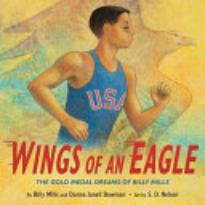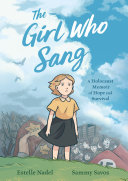Reviews of the 2025 Sibert Award Winners
Reviews of the 2025 Sibert Award winner and honorees.
Winner

 Life After Whale: The Amazing Ecosystem of a Whale Fall
Life After Whale: The Amazing Ecosystem of a Whale Fall
by Lynn Brunelle; illus. by Jason Chin
Primary, Intermediate Porter/Holiday 48 pp.
6/24 9780823452286 $18.99
e-book ed. 9780823459254 $11.99
As a ninety-year-old blue whale dies, one story ends and another begins. Her body provides food for other creatures before it gradually descends to the depths of the ocean floor. But it doesn’t stop there: her body will sustain life of one kind or another for the next few hundred years. Small marine animals, from fish to crabs to octopuses, pick the skeleton bare before another wave of animals moves in. Eventually, rich nutrients seep into the water, and that water is carried to the surface, where it nourishes krill, the major food source for blue whales. Brunelle’s engaging voice strikes the right balance between narration and exposition, while the book design adroitly places her text judiciously across double-page spreads and into sidebar columns. Chin’s (The Universe in You, rev. 1/23) always-exquisite watercolors thus dominate the layouts in a variety of double-page spreads, spot illustrations, and thumbnails—even as supplemental maps, models, and cross-sections effortlessly convey complex visual information. Back matter includes more information about blue whales, marine ecosystems, and the four distinct phases of a whale fall. Recommended resources and a select bibliography are appended as well. Dedicated enthusiasts may also want to seek out Stewart and Dunlavey’s Whale Fall (rev. 1/23). JONATHAN HUNT
From the May/June 2024 issue of The Horn Book Magazine.
Honor Books

 Call Me Roberto!: Roberto Clemente Goes to Bat for Latinos
Call Me Roberto!: Roberto Clemente Goes to Bat for Latinos
by Nathalie Alonso; illus. by Rudy Gutierrez
Primary, Intermediate Calkins/Astra 40 pp.
8/24 9781635928112 $18.99
e-book ed. 9781635928129 $11.99
In engaging, economical, and colloquial prose, Alonso chronicles the ascent and career highs of legendary right fielder Clemente (1934–1972), who endured racism as a Spanish-speaking Black man while shattering records during his illustrious baseball career. This energetic account begins with young Roberto playing béisbol in Carolina, Puerto Rico, using crinkled-up cans for baseballs and branches for bats. After a talent scout spots him in 1955, the nineteen-year-old travels to Montreal, where he spends more time on the bench than the field. Then he joins the Pittsburgh Pirates and impresses everyone with his ability to hit, slide, and leap for catches. Alonso (a journalist for MLB.com) writes with the immediacy of a play-by-play announcer, whisking readers from one achievement to the next. She directly addresses the extreme prejudice Clemente experienced: crowds heckle him for speaking español; dismissive reporters insist on calling him Bob instead of Roberto. Gutierrez’s inventive mixed-media illustrations explode with dynamic colors and kinetic motion. Each double-page spread resembles an intricate mural, capturing jumps in time and changes in locale with swirls and attention-grabbing line work. While Gutierrez employs many abstract touches throughout, he gives Clemente an expressive photorealistic face that shows his determination and drive. Excellent back matter includes a timeline, a bibliography, photos, and an informative note from Alonso. BRIAN E. WILSON
From the September/October 2024 issue of The Horn Book Magazine.

 The Enigma Girls: How Ten Teenagers Broke Ciphers, Kept Secrets, and Helped Win World War II
The Enigma Girls: How Ten Teenagers Broke Ciphers, Kept Secrets, and Helped Win World War II
by Candace Fleming
Middle School, High School Focus/Scholastic 384 pp.
3/24 9781338749571 $19.99
e-book ed. 9781338749588 $19.99
Bletchley Park, a World War II cryptology center, operated in the English countryside where an extensive and complicated code-breaking operation allowed the Allies to decipher secret messages sent through German Enigma machines. Those transmissions included enemy plans for naval attacks, ship locations, ground positions, and bombing targets, and Fleming (Crash from Outer Space, rev. 11/22, among many others) reveals that the feat of decoding the thousands of pieces of information every day was largely executed by teenage girls and young women. Recruited with little or no knowledge of what their jobs would be, the code breakers were sworn to secrecy—an oath that would remain unbroken for over thirty years. Fleming’s account focuses on ten such young women (one of whom is an offsite radio operator) but, in a masterful presentation of related subject matter, seamlessly intersperses segments on larger historical events, beginning with the Battle of Britain and concluding with V-J Day; clear and thorough explanations of codes and ciphers; and technical advances that led to the use of computers. The girls’ personal experiences, from coping with housing shortages, to falling in love, to discovering their future life’s work, adds another dimension. Amid the often-tedious work of breaking the ciphers, moments of humanity appear: the joy of pinpointing an enemy bombing target on British soil; the recognition that a freshly bloodstained Nazi cipher book meant “somewhere this German airman was still bleeding, dying maybe…That really did bring the war close.” Appended with an author’s note, a bibliography of both primary and secondary sources, source notes, and an (unseen) index. BETTY CARTER
From the May/June 2024 issue of The Horn Book Magazine.

 Wings of an Eagle: The Gold Medal Dreams of Billy Mills
Wings of an Eagle: The Gold Medal Dreams of Billy Mills
by Billy Mills and Donna Janell Bowman; illus. by S. D. Nelson
Primary, Intermediate Little, Brown 48 pp.
7/24 9780316373487 $19.99
Born on the Oglala Lakota Nation’s Pine Ridge Reservation and orphaned at a young age, a grieving Billy Mills focuses on his father’s advice: “The pursuit of a dream will heal you.” Mills’s dream is to follow in the footsteps of Native athletes Jim Thorpe and Buster Charles. That dream takes him to the University of Kansas’s track team and eventually the 1964 Olympic Games in Tokyo. Mills confronts racism and health challenges (he is hypoglycemic) at every turn, but his belief in his dream pushes him to overcome all obstacles. Mills becomes one of only two Indigenous American Olympic track-and-field gold medalists when he beats the odds and wins gold in the 10,000-meter event. Written in propulsive and inspiring first-person free verse, this picture-book autobiography is a celebration of Mills, his legacy, and the power of inspiration. Nelson’s acrylic illustrations capture Mills’s Lakota upbringing, athletic pursuits, determination, and Olympic triumphs with grace and kinetic energy. Sun-drenched pages feature symbolic textures that imbue the art with a visual representation of the ancestral support the text references throughout. Additional information about Mills’s life and charitable work off the track, photographs, a timeline, and notes from the three creators complete this stunning package, an essential addition for all sports fans. ERIC CARPENTER
From the November/December 2024 issue of The Horn Book Magazine.
 The Girl Who Sang: A Holocaust Memoir of Hope and Survival
The Girl Who Sang: A Holocaust Memoir of Hope and Survival
by Estelle Nadel with Sammy Savos and Bethany Strout; illus. by Sammy Savos
Intermediate, Middle School Roaring Brook 272 pp.
1/24 9781250247766 $25.99
Paper ed. 9781250247773 $17.99
e-book ed. 9781250366672 $11.99
At the start of this compelling graphic memoir, four-year-old Enia Feld lives a seemingly carefree life with her loving extended family in 1939 Borek, Poland. Though they are “very, very poor”—and there are hints of antisemitism and violence to come—Enia feels safe, secure, and well cared for, her voice constantly lifted in song. “And I thought we would be this happy forever.” On September 1, though, Germany invades. The family’s rights are continually eroded (“Things changed over the next two years. Slowly”) until, inevitably, they are forced to flee for their lives. In five dramatic parts—Innocence, Hidden, Liberation, A New Beginning, The Girl Who Sang—this harrowing story is told and shown in clear sequential art that reflects the terror and grief of Enia’s experiences in contrast with her early, pastoral-set days. When liberation finally occurs, after years of whispers in hiding, the once-vivacious girl has gone nearly silent, but it’s in finding her voice that she is able to begin a new life in America. The history is deeply personal, as related by Nadel (who passed away in November 2023), and her intent is made clear in her concluding note: “I’m not going to be here forever. Someday there will no longer be Holocaust survivors still living…I want you, the young people, the next generation, to carry our stories on.” An afterword, family photos, additional resources, an illustrator’s note, and details about comics are appended. ELISSA GERSHOWITZ
From the March/April 2024 issue of The Horn Book Magazine.
For more, click on the tag ALA LibLearnX 2025.
RELATED
ALREADY A SUBSCRIBER? LOG IN
We are currently offering this content for free. Sign up now to activate your personal profile, where you can save articles for future viewing.







Add Comment :-
Be the first reader to comment.
Comment Policy:
Comment should not be empty !!!